low oil pressure FORD SIERRA 1991 2.G Reference Workshop Manual
[x] Cancel search | Manufacturer: FORD, Model Year: 1991, Model line: SIERRA, Model: FORD SIERRA 1991 2.GPages: 26, PDF Size: 0.57 MB
Page 5 of 26
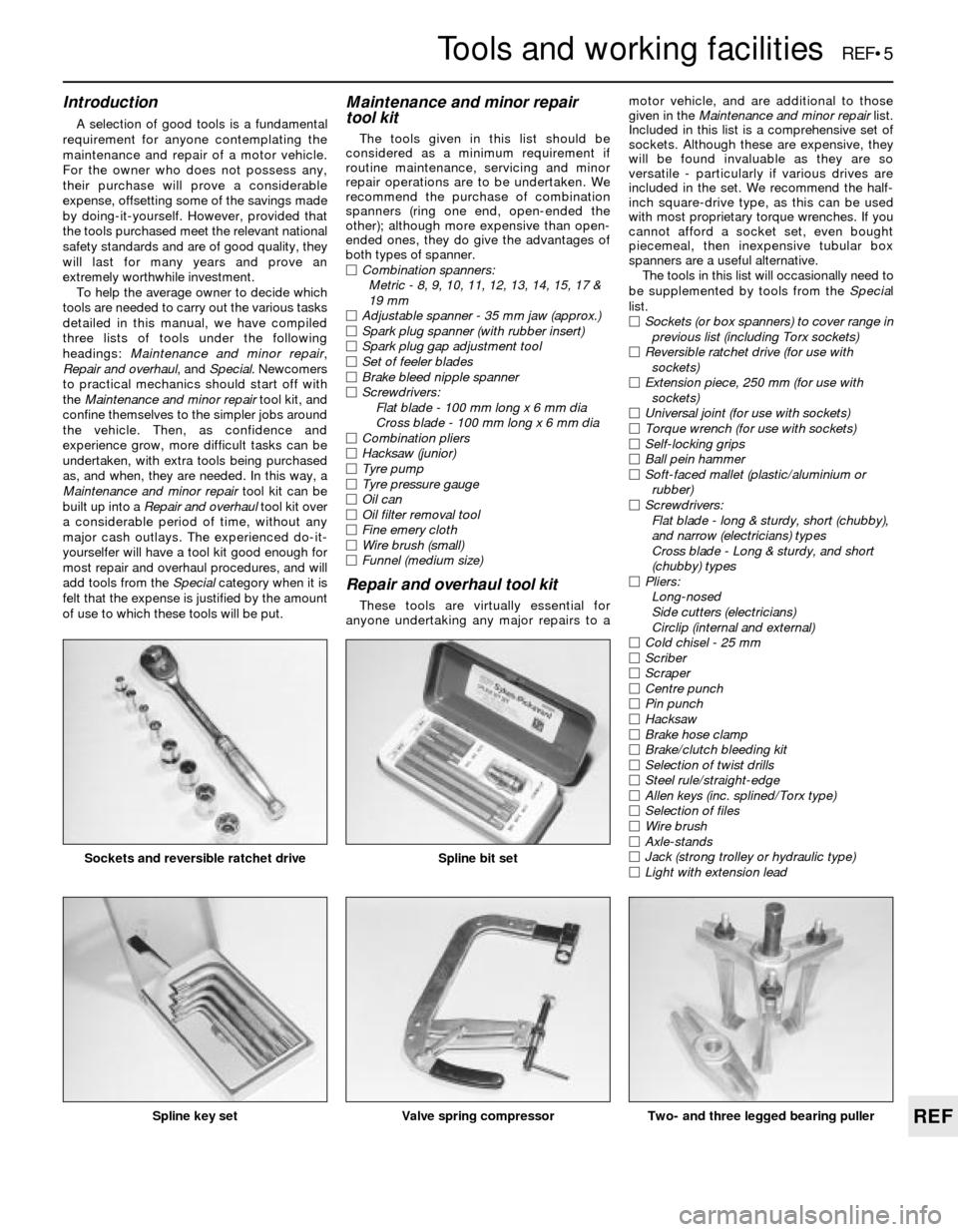
Introduction
A selection of good tools is a fundamental
requirement for anyone contemplating the
maintenance and repair of a motor vehicle.
For the owner who does not possess any,
their purchase will prove a considerable
expense, offsetting some of the savings made
by doing-it-yourself. However, provided that
the tools purchased meet the relevant national
safety standards and are of good quality, they
will last for many years and prove an
extremely worthwhile investment.
To help the average owner to decide which
tools are needed to carry out the various tasks
detailed in this manual, we have compiled
three lists of tools under the following
headings: Maintenance and minor repair,
Repair and overhaul, and Special. Newcomers
to practical mechanics should start off with
the Maintenance and minor repairtool kit, and
confine themselves to the simpler jobs around
the vehicle. Then, as confidence and
experience grow, more difficult tasks can be
undertaken, with extra tools being purchased
as, and when, they are needed. In this way, a
Maintenance and minor repairtool kit can be
built up into a Repair and overhaultool kit over
a considerable period of time, without any
major cash outlays. The experienced do-it-
yourselfer will have a tool kit good enough for
most repair and overhaul procedures, and will
add tools from the Specialcategory when it is
felt that the expense is justified by the amount
of use to which these tools will be put.
Maintenance and minor repair
tool kit
The tools given in this list should be
considered as a minimum requirement if
routine maintenance, servicing and minor
repair operations are to be undertaken. We
recommend the purchase of combination
spanners (ring one end, open-ended the
other); although more expensive than open-
ended ones, they do give the advantages of
both types of spanner.
MCombination spanners:
Metric - 8, 9, 10, 11, 12, 13, 14, 15, 17 &
19 mm
MAdjustable spanner - 35 mm jaw (approx.)
MSpark plug spanner (with rubber insert)
MSpark plug gap adjustment tool
MSet of feeler blades
MBrake bleed nipple spanner
MScrewdrivers:
Flat blade - 100 mm long x 6 mm dia
Cross blade - 100 mm long x 6 mm dia
MCombination pliers
MHacksaw (junior)
MTyre pump
MTyre pressure gauge
MOil can
MOil filter removal tool
MFine emery cloth
MWire brush (small)
MFunnel (medium size)
Repair and overhaul tool kit
These tools are virtually essential for
anyone undertaking any major repairs to amotor vehicle, and are additional to those
given in the Maintenance and minor repairlist.
Included in this list is a comprehensive set of
sockets. Although these are expensive, they
will be found invaluable as they are so
versatile - particularly if various drives are
included in the set. We recommend the half-
inch square-drive type, as this can be used
with most proprietary torque wrenches. If you
cannot afford a socket set, even bought
piecemeal, then inexpensive tubular box
spanners are a useful alternative.
The tools in this list will occasionally need to
be supplemented by tools from the Special
list.
MSockets (or box spanners) to cover range in
previous list (including Torx sockets)
MReversible ratchet drive (for use with
sockets)
MExtension piece, 250 mm (for use with
sockets)
MUniversal joint (for use with sockets)
MTorque wrench (for use with sockets)
MSelf-locking grips
MBall pein hammer
MSoft-faced mallet (plastic/aluminium or
rubber)
MScrewdrivers:
Flat blade - long & sturdy, short (chubby),
and narrow (electricians) types
Cross blade - Long & sturdy, and short
(chubby) types
MPliers:
Long-nosed
Side cutters (electricians)
Circlip (internal and external)
MCold chisel - 25 mm
MScriber
MScraper
MCentre punch
MPin punch
MHacksaw
MBrake hose clamp
MBrake/clutch bleeding kit
MSelection of twist drills
MSteel rule/straight-edge
MAllen keys (inc. splined/Torx type)
MSelection of files
MWire brush
MAxle-stands
MJack (strong trolley or hydraulic type)
MLight with extension lead
Tools and working facilities REF•5
Sockets and reversible ratchet driveSpline bit set
Spline key setValve spring compressorTwo- and three legged bearing pullerREF
Page 9 of 26
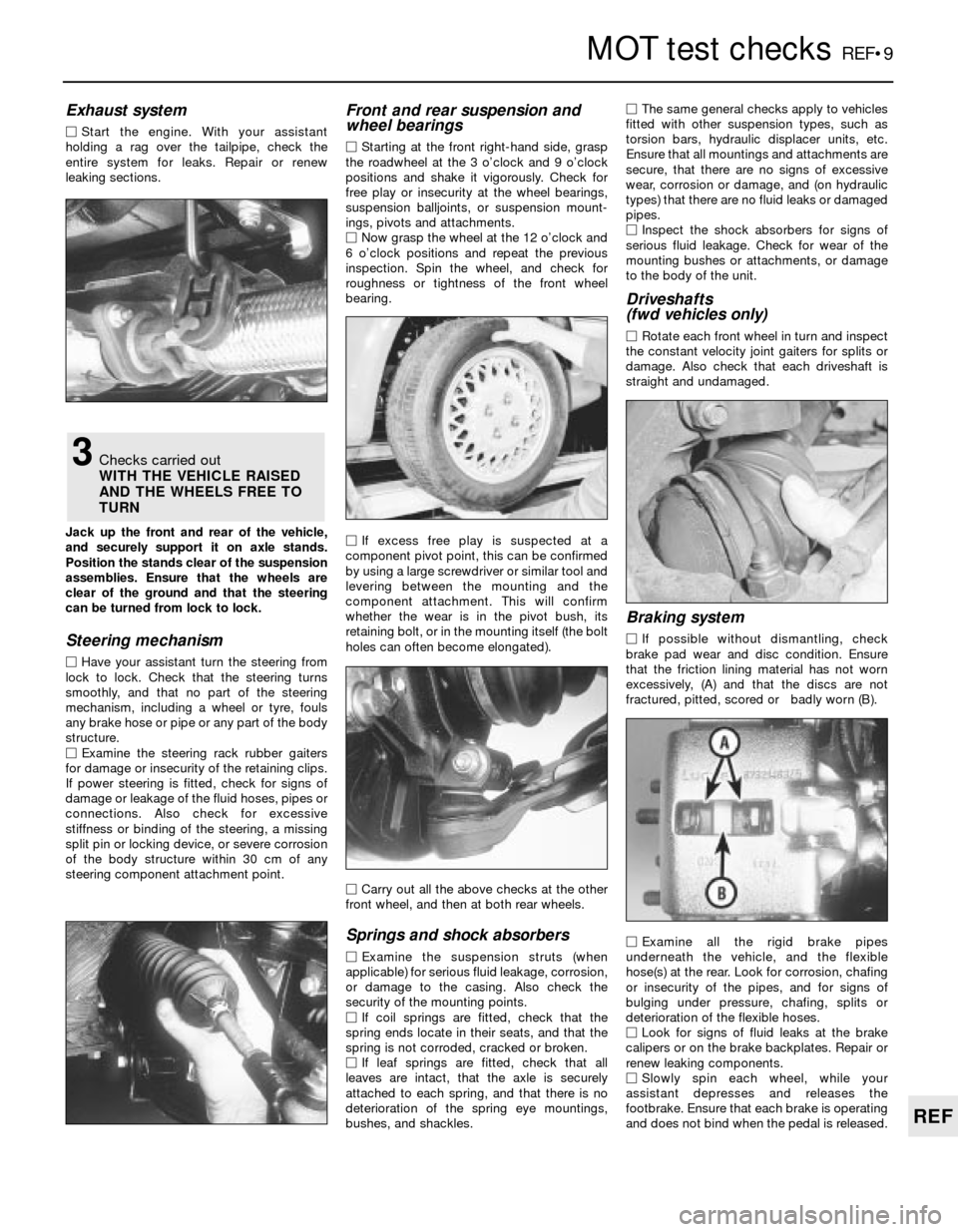
MOTtest checksREF•9
REF
Exhaust system
MStart the engine. With your assistant
holding a rag over the tailpipe, check the
entire system for leaks. Repair or renew
leaking sections.
Jack up the front and rear of the vehicle,
and securely support it on axle stands.
Position the stands clear of the suspension
assemblies. Ensure that the wheels are
clear of the ground and that the steering
can be turned from lock to lock.
Steering mechanism
MHave your assistant turn the steering from
lock to lock. Check that the steering turns
smoothly, and that no part of the steering
mechanism, including a wheel or tyre, fouls
any brake hose or pipe or any part of the body
structure.
MExamine the steering rack rubber gaiters
for damage or insecurity of the retaining clips.
If power steering is fitted, check for signs of
damage or leakage of the fluid hoses, pipes or
connections. Also check for excessive
stiffness or binding of the steering, a missing
split pin or locking device, or severe corrosion
of the body structure within 30 cm of any
steering component attachment point.
Front and rear suspension and
wheel bearings
MStarting at the front right-hand side, grasp
the roadwheel at the 3 o’clock and 9 o’clock
positions and shake it vigorously. Check for
free play or insecurity at the wheel bearings,
suspension balljoints, or suspension mount-
ings, pivots and attachments.
MNow grasp the wheel at the 12 o’clock and
6 o’clock positions and repeat the previous
inspection. Spin the wheel, and check for
roughness or tightness of the front wheel
bearing.
MIf excess free play is suspected at a
component pivot point, this can be confirmed
by using a large screwdriver or similar tool and
levering between the mounting and the
component attachment. This will confirm
whether the wear is in the pivot bush, its
retaining bolt, or in the mounting itself (the bolt
holes can often become elongated).
MCarry out all the above checks at the other
front wheel, and then at both rear wheels.
Springs and shock absorbers
MExamine the suspension struts (when
applicable) for serious fluid leakage, corrosion,
or damage to the casing. Also check the
security of the mounting points.
MIf coil springs are fitted, check that the
spring ends locate in their seats, and that the
spring is not corroded, cracked or broken.
MIf leaf springs are fitted, check that all
leaves are intact, that the axle is securely
attached to each spring, and that there is no
deterioration of the spring eye mountings,
bushes, and shackles.MThe same general checks apply to vehicles
fitted with other suspension types, such as
torsion bars, hydraulic displacer units, etc.
Ensure that all mountings and attachments are
secure, that there are no signs of excessive
wear, corrosion or damage, and (on hydraulic
types) that there are no fluid leaks or damaged
pipes.
MInspect the shock absorbers for signs of
serious fluid leakage. Check for wear of the
mounting bushes or attachments, or damage
to the body of the unit.
Driveshafts
(fwd vehicles only)
MRotate each front wheel in turn and inspect
the constant velocity joint gaiters for splits or
damage. Also check that each driveshaft is
straight and undamaged.
Braking system
MIf possible without dismantling, check
brake pad wear and disc condition. Ensure
that the friction lining material has not worn
excessively, (A) and that the discs are not
fractured, pitted, scored or badly worn (B).
MExamine all the rigid brake pipes
underneath the vehicle, and the flexible
hose(s) at the rear. Look for corrosion, chafing
or insecurity of the pipes, and for signs of
bulging under pressure, chafing, splits or
deterioration of the flexible hoses.
MLook for signs of fluid leaks at the brake
calipers or on the brake backplates. Repair or
renew leaking components.
MSlowly spin each wheel, while your
assistant depresses and releases the
footbrake. Ensure that each brake is operating
and does not bind when the pedal is released.
3Checks carried out
WITH THE VEHICLE RAISED
AND THE WHEELS FREE TO
TURN
Page 10 of 26
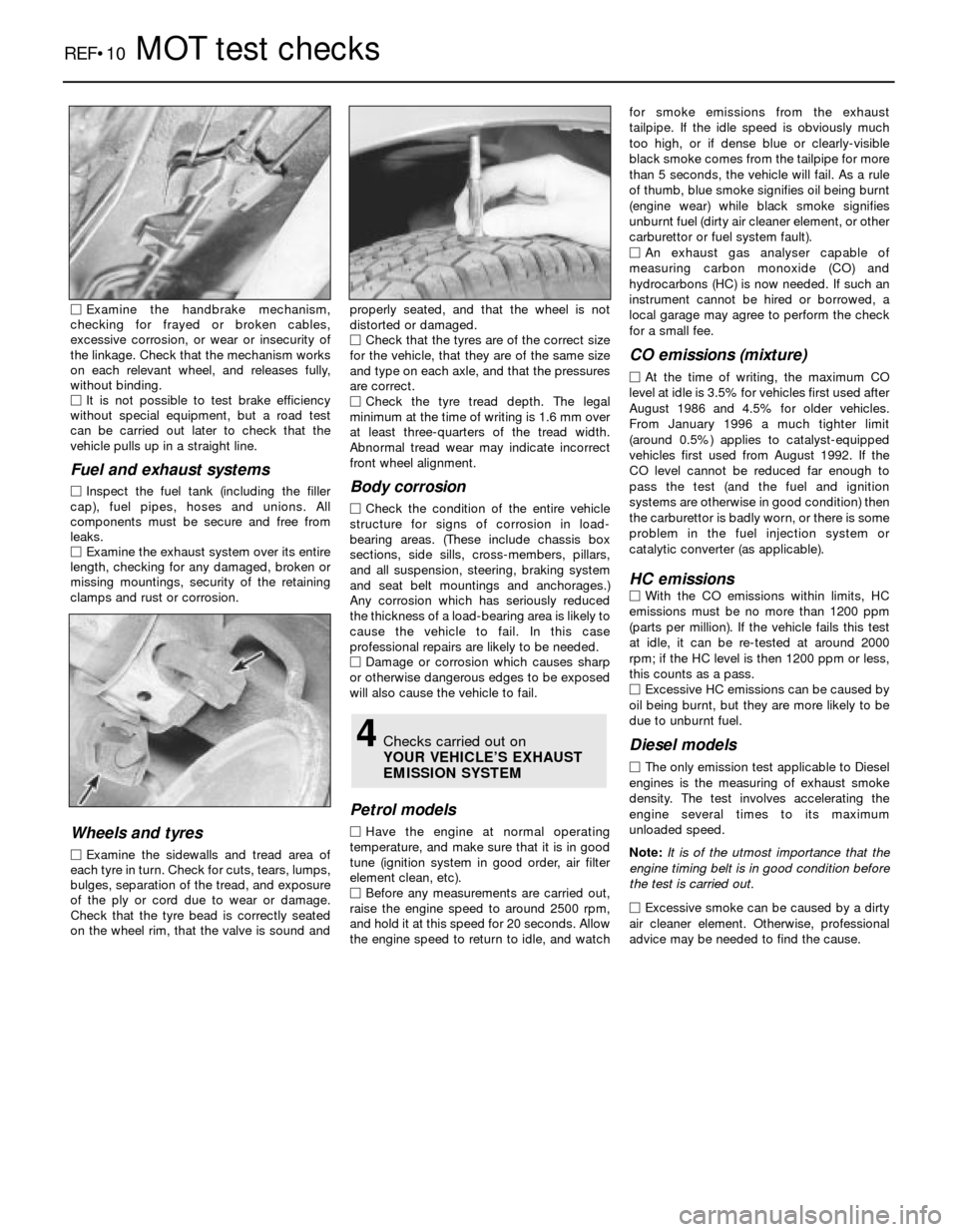
REF•10MOTtest checks
MExamine the handbrake mechanism,
checking for frayed or broken cables,
excessive corrosion, or wear or insecurity of
the linkage. Check that the mechanism works
on each relevant wheel, and releases fully,
without binding.
MIt is not possible to test brake efficiency
without special equipment, but a road test
can be carried out later to check that the
vehicle pulls up in a straight line.
Fuel and exhaust systems
MInspect the fuel tank (including the filler
cap), fuel pipes, hoses and unions. All
components must be secure and free from
leaks.
MExamine the exhaust system over its entire
length, checking for any damaged, broken or
missing mountings, security of the retaining
clamps and rust or corrosion.
Wheels and tyres
MExamine the sidewalls and tread area of
each tyre in turn. Check for cuts, tears, lumps,
bulges, separation of the tread, and exposure
of the ply or cord due to wear or damage.
Check that the tyre bead is correctly seated
on the wheel rim, that the valve is sound andproperly seated, and that the wheel is not
distorted or damaged.
MCheck that the tyres are of the correct size
for the vehicle, that they are of the same size
and type on each axle, and that the pressures
are correct.
MCheck the tyre tread depth. The legal
minimum at the time of writing is 1.6 mm over
at least three-quarters of the tread width.
Abnormal tread wear may indicate incorrect
front wheel alignment.
Body corrosion
MCheck the condition of the entire vehicle
structure for signs of corrosion in load-
bearing areas. (These include chassis box
sections, side sills, cross-members, pillars,
and all suspension, steering, braking system
and seat belt mountings and anchorages.)
Any corrosion which has seriously reduced
the thickness of a load-bearing area is likely to
cause the vehicle to fail. In this case
professional repairs are likely to be needed.
MDamage or corrosion which causes sharp
or otherwise dangerous edges to be exposed
will also cause the vehicle to fail.
Petrol models
MHave the engine at normal operating
temperature, and make sure that it is in good
tune (ignition system in good order, air filter
element clean, etc).
MBefore any measurements are carried out,
raise the engine speed to around 2500 rpm,
and hold it at this speed for 20 seconds. Allow
the engine speed to return to idle, and watchfor smoke emissions from the exhaust
tailpipe. If the idle speed is obviously much
too high, or if dense blue or clearly-visible
black smoke comes from the tailpipe for more
than 5 seconds, the vehicle will fail. As a rule
of thumb, blue smoke signifies oil being burnt
(engine wear) while black smoke signifies
unburnt fuel (dirty air cleaner element, or other
carburettor or fuel system fault).
MAn exhaust gas analyser capable of
measuring carbon monoxide (CO) and
hydrocarbons (HC) is now needed. If such an
instrument cannot be hired or borrowed, a
local garage may agree to perform the check
for a small fee.
CO emissions (mixture)
MAt the time of writing, the maximum CO
level at idle is 3.5% for vehicles first used after
August 1986 and 4.5% for older vehicles.
From January 1996 a much tighter limit
(around 0.5%) applies to catalyst-equipped
vehicles first used from August 1992. If the
CO level cannot be reduced far enough to
pass the test (and the fuel and ignition
systems are otherwise in good condition) then
the carburettor is badly worn, or there is some
problem in the fuel injection system or
catalytic converter (as applicable).
HC emissionsMWith the CO emissions within limits, HC
emissions must be no more than 1200 ppm
(parts per million). If the vehicle fails this test
at idle, it can be re-tested at around 2000
rpm; if the HC level is then 1200 ppm or less,
this counts as a pass.
MExcessive HC emissions can be caused by
oil being burnt, but they are more likely to be
due to unburnt fuel.
Diesel models
MThe only emission test applicable to Diesel
engines is the measuring of exhaust smoke
density. The test involves accelerating the
engine several times to its maximum
unloaded speed.
Note: It is of the utmost importance that the
engine timing belt is in good condition before
the test is carried out.
M
Excessive smoke can be caused by a dirty
air cleaner element. Otherwise, professional
advice may be needed to find the cause.
4Checks carried out on
YOUR VEHICLE’S EXHAUST
EMISSION SYSTEM
Page 11 of 26
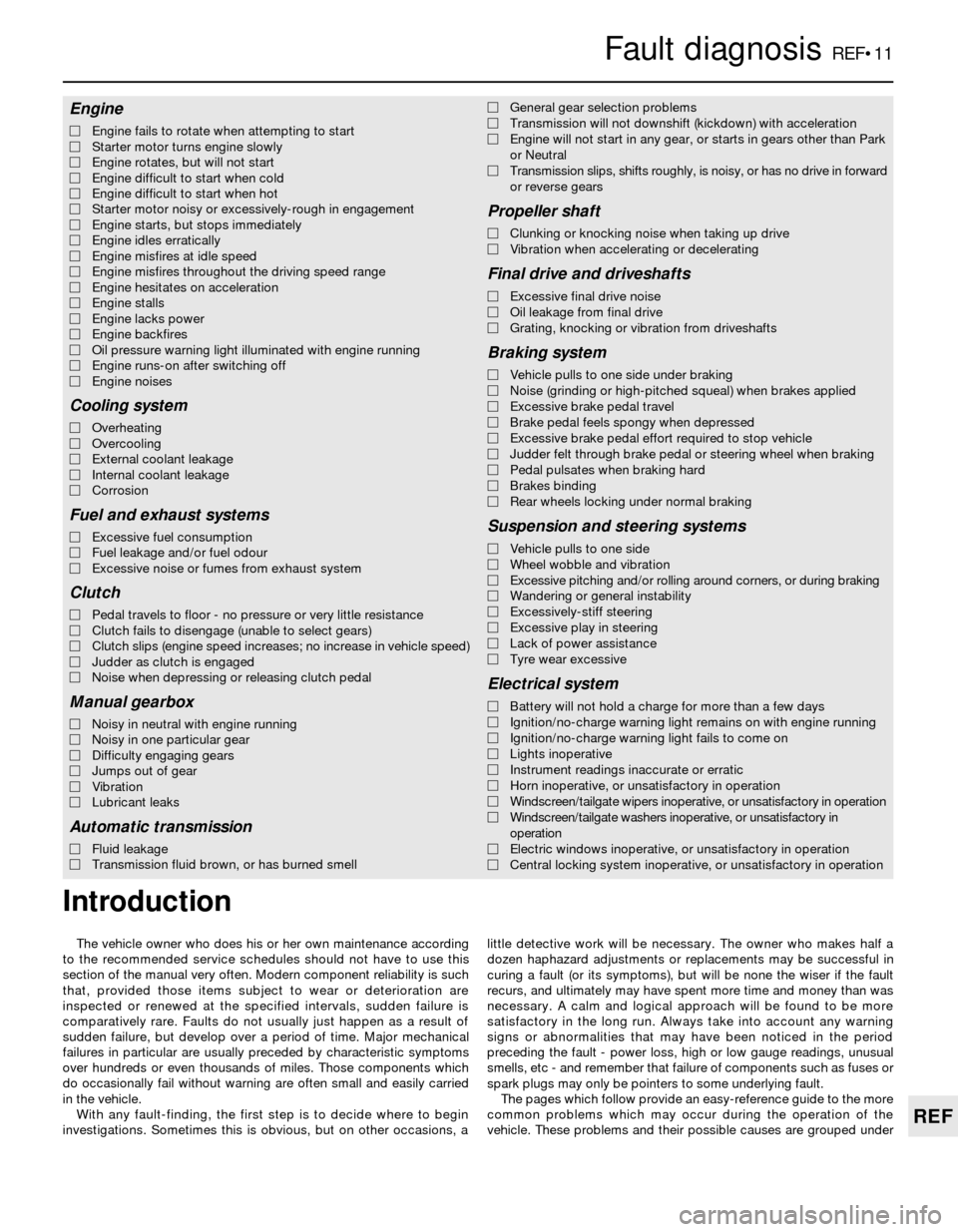
The vehicle owner who does his or her own maintenance according
to the recommended service schedules should not have to use this
section of the manual very often. Modern component reliability is such
that, provided those items subject to wear or deterioration are
inspected or renewed at the specified intervals, sudden failure is
comparatively rare. Faults do not usually just happen as a result of
sudden failure, but develop over a period of time. Major mechanical
failures in particular are usually preceded by characteristic symptoms
over hundreds or even thousands of miles. Those components which
do occasionally fail without warning are often small and easily carried
in the vehicle.
With any fault-finding, the first step is to decide where to begin
investigations. Sometimes this is obvious, but on other occasions, alittle detective work will be necessary. The owner who makes half a
dozen haphazard adjustments or replacements may be successful in
curing a fault (or its symptoms), but will be none the wiser if the fault
recurs, and ultimately may have spent more time and money than was
necessary. A calm and logical approach will be found to be more
satisfactory in the long run. Always take into account any warning
signs or abnormalities that may have been noticed in the period
preceding the fault - power loss, high or low gauge readings, unusual
smells, etc - and remember that failure of components such as fuses or
spark plugs may only be pointers to some underlying fault.
The pages which follow provide an easy-reference guide to the more
common problems which may occur during the operation of the
vehicle. These problems and their possible causes are grouped under
Fault diagnosisREF•11
REF
Engine
MEngine fails to rotate when attempting to start
MStarter motor turns engine slowly
MEngine rotates, but will not start
MEngine difficult to start when cold
MEngine difficult to start when hot
MStarter motor noisy or excessively-rough in engagement
MEngine starts, but stops immediately
MEngine idles erratically
MEngine misfires at idle speed
MEngine misfires throughout the driving speed range
MEngine hesitates on acceleration
MEngine stalls
MEngine lacks power
MEngine backfires
MOil pressure warning light illuminated with engine running
MEngine runs-on after switching off
MEngine noises
Cooling system
MOverheating
MOvercooling
MExternal coolant leakage
MInternal coolant leakage
MCorrosion
Fuel and exhaust systems
MExcessive fuel consumption
MFuel leakage and/or fuel odour
MExcessive noise or fumes from exhaust system
Clutch
MPedal travels to floor - no pressure or very little resistance
MClutch fails to disengage (unable to select gears)
MClutch slips (engine speed increases; no increase in vehicle speed)
MJudder as clutch is engaged
MNoise when depressing or releasing clutch pedal
Manual gearbox
MNoisy in neutral with engine running
MNoisy in one particular gear
MDifficulty engaging gears
MJumps out of gear
MVibration
MLubricant leaks
Automatic transmission
MFluid leakage
MTransmission fluid brown, or has burned smellMGeneral gear selection problems
MTransmission will not downshift (kickdown) with acceleration
MEngine will not start in any gear, or starts in gears other than Park
or Neutral
MTransmission slips, shifts roughly, is noisy, or has no drive in forward
or reverse gears
Propeller shaft
MClunking or knocking noise when taking up drive
MVibration when accelerating or decelerating
Final drive and driveshafts
MExcessive final drive noise
MOil leakage from final drive
MGrating, knocking or vibration from driveshafts
Braking system
MVehicle pulls to one side under braking
MNoise (grinding or high-pitched squeal) when brakes applied
MExcessive brake pedal travel
MBrake pedal feels spongy when depressed
MExcessive brake pedal effort required to stop vehicle
MJudder felt through brake pedal or steering wheel when braking
MPedal pulsates when braking hard
MBrakes binding
MRear wheels locking under normal braking
Suspension and steering systems
MVehicle pulls to one side
MWheel wobble and vibration
MExcessive pitching and/or rolling around corners, or during braking
MWandering or general instability
MExcessively-stiff steering
MExcessive play in steering
MLack of power assistance
MTyre wear excessive
Electrical system
MBattery will not hold a charge for more than a few days
MIgnition/no-charge warning light remains on with engine running
MIgnition/no-charge warning light fails to come on
MLights inoperative
MInstrument readings inaccurate or erratic
MHorn inoperative, or unsatisfactory in operation
MWindscreen/tailgate wipers inoperative, or unsatisfactory in operation
MWindscreen/tailgate washers inoperative, or unsatisfactory in
operation
MElectric windows inoperative, or unsatisfactory in operation
MCentral locking system inoperative, or unsatisfactory in operation
Introduction
Page 12 of 26

headings denoting various components or systems, such as Engine,
Cooling system, etc. The Chapter and/or Section which deals with the
problem is also shown in brackets. Whatever the fault, certain basic
principles apply. These are as follows:
Verify the fault. This is simply a matter of being sure that you know
what the symptoms are before starting work. This is particularly
important if you are investigating a fault for someone else, who may
not have described it very accurately.
Don’t overlook the obvious. For example, if the vehicle won’t start, is
there fuel in the tank? (Don’t take anyone else’s word on this particular
point, and don’t trust the fuel gauge either!) If an electrical fault is
indicated, look for loose or broken wires before digging out the test
gear.Cure the disease, not the symptom. Substituting a flat battery with a
fully-charged one will get you off the hard shoulder, but if the
underlying cause is not attended to, the new battery will go the same
way. Similarly, changing oil-fouled spark plugs for a new set will get
you moving again, but remember that the reason for the fouling (if it
wasn’t simply an incorrect grade of plug) will have to be established
and corrected.
Don’t take anything for granted. Particularly, don’t forget that a
“new” component may itself be defective (especially if it’s been rattling
around in the boot for months), and don’t leave components out of a
fault diagnosis sequence just because they are new or recently-fitted.
When you do finally diagnose a difficult fault, you’ll probably realise
that all the evidence was there from the start.
Engine fails to rotate when attempting to start
MBattery terminal connections loose or corroded (Chapter 1).
MBattery discharged or faulty (Chapter 5).
MBroken, loose or disconnected wiring in the starting circuit (Chapter 5).
MDefective starter solenoid or switch (Chapter 5).
MDefective starter motor (Chapter 5).
MStarter pinion or flywheel/driveplate ring gear teeth loose or broken
(Chapters 2 or 5).
MEngine earth strap broken or disconnected.
Starter motor turns engine slowly
MPartially-discharged battery (recharge, use jump leads, or push start)
(Chapter 5).
MBattery terminals loose or corroded (Chapter 1).
MBattery earth to body defective (Chapter 5).
MEngine earth strap loose.
MStarter motor (or solenoid) wiring loose (Chapter 5).
MStarter motor internal fault (Chapter 5).
Engine rotates, but will not start
MFuel pump inertia switch tripped (electric pump) (Chapter 4).
MFuel tank empty.
MBattery discharged (engine rotates slowly) (Chapter 5).
MBattery terminal connections loose or corroded (Chapter 1).
MIgnition components damp or damaged (Chapters 1 and 5).
MBroken, loose or disconnected wiring in the ignition circuit (Chapters 1
and 5).
MWorn, faulty or incorrectly-gapped spark plugs (Chapter 1).
MFuel injection system fault (Chapter 4).
MMajor mechanical failure (eg broken timing chain) (Chapter 2).
Engine difficult to start when cold
MBattery discharged (Chapter 5).
MBattery terminal connections loose or corroded (Chapter 1).
MWorn, faulty or incorrectly-gapped spark plugs (Chapter 1).
MFuel injection system fault (Chapter 4).
MOther ignition system fault (Chapters 1 and 5).
MLow cylinder compressions (Chapter 2).
Engine difficult to start when hot
MAir filter element dirty or clogged (Chapter 1).
MFuel injection system fault (Chapter 4).
MLow cylinder compressions (Chapter 2).
Starter motor noisy or excessively-rough in
engagement
MStarter pinion or flywheel/driveplate ring gear teeth loose or broken
(Chapters 2 or 5).
MStarter motor mounting bolts loose or missing (Chapter 5).
MStarter motor internal components worn or damaged (Chapter 5).
Engine starts, but stops immediately
MLoose or faulty electrical connections in the ignition circuit
(Chapters 1 and 5).
MVacuum leak at the throttle body or inlet manifold (Chapter 4).
MFuel injection system fault (Chapter 4).
Engine idles erratically
MIncorrectly-adjusted idle speed (Chapter 4).
MAir filter element clogged (Chapter 1).
MVacuum leak at the throttle body, inlet manifold or associated
hoses (Chapter 4).
MWorn, faulty or incorrectly-gapped spark plugs (Chapter 1).
MUneven or low cylinder compressions (Chapter 2).
MCamshaft lobes worn (Chapter 2).
MFuel injection system fault (Chapter 4).
Engine misfires at idle speed
MWorn, faulty or incorrectly-gapped spark plugs (Chapter 1).
MFaulty spark plug HT leads (Chapter 5).
MVacuum leak at the throttle body, inlet manifold or associated
hoses (Chapter 4).
MFuel injection system fault (Chapter 4).
MDistributor cap cracked or tracking internally, where applicable
(Chapter 5).
MUneven or low cylinder compressions (Chapter 2).
MDisconnected, leaking, or perished crankcase ventilation hoses
(Chapter 4).
Engine misfires throughout the driving speed range
MFuel filter choked (Chapter 1).
MFuel pump faulty, or delivery pressure low (Chapter 4).
MFuel tank vent blocked, or fuel pipes restricted (Chapter 4).
MVacuum leak at the throttle body, inlet manifold or associated
hoses (Chapter 4).
MWorn, faulty or incorrectly-gapped spark plugs (Chapter 1).
MFaulty spark plug HT leads (Chapter 5).
MDistributor cap cracked or tracking internally, where applicable
(Chapter 5).
MFaulty ignition coil (Chapter 5).
MUneven or low cylinder compressions (Chapter 2).
MFuel injection system fault (Chapter 4).
Engine hesitates on acceleration
MWorn, faulty or incorrectly-gapped spark plugs (Chapter 1).
MVacuum leak at the throttle body, inlet manifold or associated
hoses (Chapter 4).
MFuel injection system fault (Chapter 4).
Engine stalls
MVacuum leak at the throttle body, inlet manifold or associated
hoses (Chapter 4).
REF•12Fault diagnosis
Engine
Page 13 of 26

MFuel filter choked (Chapter 1).
MFuel pump faulty, or delivery pressure low (Chapter 4).
MFuel tank vent blocked, or fuel pipes restricted (Chapter 4).
MFuel injection system fault (Chapter 4).
Engine lacks power
MFuel filter choked (Chapter 1).
MFuel pump faulty, or delivery pressure low (Chapter 4).
MUneven or low cylinder compressions (Chapter 2).
MWorn, faulty or incorrectly-gapped spark plugs (Chapter 1).
MVacuum leak at the throttle body, inlet manifold or associated
hoses (Chapter 4).
MFuel injection system fault (Chapter 4).
MBrakes binding (Chapters 1 and 10).
MClutch slipping (Chapter 6).
Engine backfires
MVacuum leak at the throttle body, inlet manifold or associated
hoses (Chapter 4).
MFuel injection system fault (Chapter 4).
Oil pressure warning light illuminated with engine
running
MLow oil level, or incorrect oil grade (Chapter 1).
MFaulty oil pressure sensor (Chapter 2).
MWorn engine bearings and/or oil pump (Chapter 2).
MExcessively high engine operating temperature (Chapter 3).
MOil pressure relief valve defective (Chapter 2).
MOil pick-up strainer clogged (Chapter 2).
Note:Low oil pressure in a high-mileage engine at tickover is not
necessarily a cause for concern. Sudden pressure loss at speed is far
more significant. In any event, check the gauge or warning light sender
before condemning the engine.
Engine runs-on after switching off
MExcessive carbon build-up in engine (Chapter 2).
MExcessively high engine operating temperature (Chapter 3).
Engine noises
Pre-ignition (pinking) or knocking during acceleration or
under load
MIgnition timing incorrect/ignition system fault (Chapters 1 and 5).
MIncorrect grade of spark plug (Chapter 1).
MIncorrect grade of fuel (Chapter 1).
MVacuum leak at throttle body, inlet manifold or associated hoses
(Chapter 4).
MExcessive carbon build-up in engine (Chapter 2).
MFuel injection system fault (Chapter 4).
Whistling or wheezing noises
MLeaking inlet manifold or throttle body gasket (Chapter 4).
MLeaking exhaust manifold gasket (Chapter 4).
MLeaking vacuum hose (Chapters 4 and 10).
MBlowing cylinder head gasket (Chapter 2).
Tapping or rattling noises
MWorn valve gear, timing chain, camshaft or hydraulic tappets
(Chapter 2).
MAncillary component fault (water pump, alternator, etc) (Chapters 3, 5)
Knocking or thumping noises
MWorn big-end bearings (regular heavy knocking, perhaps less
under load) (Chapter 2).
MWorn main bearings (rumbling and knocking, perhaps worsening
under load) (Chapter 2).
MPiston slap (most noticeable when cold) (Chapter 2).
MAncillary component fault (water pump, alternator, etc) (Chapters 3, 5)
Overheating
MAuxiliary drivebelt broken or incorrectly adjusted (Chapter 1).
MInsufficient coolant in system (Chapter 1).
MThermostat faulty (Chapter 3).
MRadiator core blocked, or grille restricted (Chapter 3).
MElectric cooling fan or thermostatic switch faulty (Chapter 3).
MViscous-coupled fan faulty (Chapter 3).
MIgnition timing incorrect, or ignition system fault (Chapters 1 and 5).
MInaccurate temperature gauge sender unit (Chapter 3).
MAirlock in cooling system (Chapter 3).
Overcooling
MThermostat faulty (Chapter 3).
MInaccurate temperature gauge sender unit (Chapter 3).
External coolant leakage
MDeteriorated or damaged hoses or hose clips (Chapter 1).
MRadiator core or heater matrix leaking (Chapter 3).
MPressure cap faulty (Chapter 3).
MWater pump internal seal leaking (Chapter 3).
MWater pump-to-block seal leaking (Chapter 3).
MBoiling due to overheating (Chapter 3).
MCore plug leaking (Chapter 2).
Internal coolant leakage
MLeaking cylinder head gasket (Chapter 2).
MCracked cylinder head or cylinder block (Chapter 2).
Corrosion
MInfrequent draining and flushing (Chapter 1).
MIncorrect coolant mixture or inappropriate coolant type (Chapter 1).
Fault diagnosisREF•13
REF
Cooling system
Excessive fuel consumption
MAir filter element dirty or clogged (Chapter 1).
MFuel injection system fault (Chapter 4).
MIgnition timing incorrect or ignition system fault (Chapters 1 and 5).
MBrakes binding (Chapter 10).
MTyres under-inflated (Chapter 1).
Fuel leakage and/or fuel odour
MDamaged fuel tank, pipes or connections (Chapters 1 and 4).
Excessive noise or fumes from exhaust system
MLeaking exhaust system or manifold joints (Chapters 1 and 4).
MLeaking, corroded or damaged silencers or pipe (Chapters 1 and 4).
MBroken mountings causing body or suspension contact (Chapter 4).
Fuel and exhaust systems
Page 14 of 26

Note:Due to the complexity of the automatic transmission, it is difficult
for the home mechanic to properly diagnose and service this unit. For
problems other than the following, the vehicle should be taken to a
dealer service department or automatic transmission specialist.
Fluid leakage
MAutomatic transmission fluid is usually deep red in colour. Fluid
leaks should not be confused with engine oil, which can easily be
blown onto the transmission by air flow.
MTo determine the source of a leak, first remove all built-up dirt and
grime from the transmission housing and surrounding areas, using a
degreasing agent or by steam-cleaning. Drive the vehicle at low speed,
so that air flow will not blow the leak far from its source. Raise and
support the vehicle, and determine where the leak is coming from. The
following are common areas of leakage.
a)Fluid pan ( transmission “sump”).
b)Dipstick tube (Chapter 1).
c)Transmission-to-fluid cooler fluid pipes/unions (Chapter 7).
Transmission fluid brown, or has burned smell
MTransmission fluid level low, or fluid in need of renewal (Chapter 1).
General gear selection problems
MThe most likely cause of gear selection problems is a faulty or
poorly-adjusted gear selector mechanism. The following are common
problems associated with a faulty selector mechanism.
a)Engine starting in gears other than Park or Neutral.
b)Indicator on gear selector lever pointing to a gear other than the
one actually being used.
c)Vehicle moves when in Park or Neutral.
d)Poor gear shift quality, or erratic gear changes.
MRefer any problems to a Ford dealer, or transmission specialist.
Transmission will not downshift (kickdown) with
accelerator pedal fully depressed
MLow transmission fluid level (Chapter 1).
MIncorrect selector adjustment (Chapter 7).
Noisy in neutral with engine running
MInput shaft bearings worn (noise apparent with clutch pedal
released, but not when depressed) (Chapter 7).*
MClutch release bearing worn (noise apparent with clutch pedal
depressed, possibly less when released) (Chapter 6).
Noisy in one particular gear
MWorn, damaged or chipped gear teeth (Chapter 7).*
Difficulty engaging gears
MClutch fault (Chapter 6).
MWorn or damaged gear linkage (Chapter 7).
MWorn synchroniser units (Chapter 7).*
Jumps out of gear
MWorn or damaged gear linkage (Chapter 7).MWorn synchroniser units (Chapter 7).*
MWorn selector forks (Chapter 7).*
Vibration
MLack of oil (Chapter 1).
MWorn bearings (Chapter 7).*
Lubricant leaks
MLeaking oil seal (Chapter 7).
MLeaking housing joint (Chapter 7).*
*Although the corrective action necessary to remedy the symptoms
described is beyond the scope of the home mechanic, the above
information should be helpful in isolating the cause of the condition, so
that the owner can communicate clearly with a professional mechanic.
Pedal travels to floor - no pressure or very little
resistance
MBadly stretched or broken cable (Chapter 6).
MStripped pawl on pedal (Chapter 6).
MBroken clutch release bearing or arm (Chapter 6).
MBroken diaphragm spring in clutch pressure plate (Chapter 6).
Clutch fails to disengage (unable to select gears)
MCable free play excessive (Chapter 6).
MClutch driven plate sticking on gearbox input shaft splines
(Chapter 6).
MClutch driven plate sticking to flywheel or pressure plate (Chapter 6).
MFaulty pressure plate assembly (Chapter 6).
MClutch release mechanism worn or incorrectly assembled (Chapter 6).
Clutch slips (engine speed increases, with no
increase in vehicle speed)
MClutch driven plate linings excessively worn (Chapter 6).MClutch driven plate linings contaminated with oil or grease (Chapter 6).
MFaulty pressure plate or weak diaphragm spring (Chapter 6).
Judder as clutch is engaged
MClutch driven plate linings contaminated with oil or grease (Chapter 6).
MClutch driven plate linings excessively worn (Chapter 6).
MFaulty or distorted pressure plate or diaphragm spring (Chapter 6).
MWorn or loose engine or gearbox mountings (Chapter 2).
MClutch driven plate hub or gearbox input shaft splines worn
(Chapter 6).
Noise when depressing or releasing clutch pedal
MWorn clutch release bearing (Chapter 6).
MWorn or dry clutch pedal pivot (Chapter 6).
MFaulty pressure plate assembly (Chapter 6).
MPressure plate diaphragm spring broken (Chapter 6).
MBroken clutch driven plate cushioning springs (Chapter 6).
REF•14Fault diagnosis
Clutch
Manual gearbox
Automatic transmission
Page 16 of 26

Brakes binding
MSeized brake caliper piston(s) (Chapter 10).
MIncorrectly-adjusted handbrake mechanism (Chapter 10).
MFaulty master cylinder (Chapter 10).
Rear wheels locking under normal braking
MSeized brake caliper piston(s) (Chapter 10).
MFaulty brake pressure regulator (Chapter 10).
Note:For problems associated with the starting system, refer to the
faults listed under “Engine” earlier in this Section.
Battery will not hold a charge for more than a few
days
MBattery defective internally (Chapter 5).
MBattery electrolyte level low - where applicable (Chapter 1).
MBattery terminal connections loose or corroded (Chapter 1).
MAuxiliary drivebelt worn - or incorrectly adjusted (Chapter 1).
MAlternator not charging at correct output (Chapter 5).MAlternator or voltage regulator faulty (Chapter 5).
MShort-circuit causing continual battery drain (Chapters 5 and 13).
Ignition/no-charge warning light remains illuminated
with engine running
MAuxiliary drivebelt broken, worn, or incorrectly adjusted (Chapter 1).
MAlternator brushes worn, sticking, or dirty (Chapter 5).
MAlternator brush springs weak or broken (Chapter 5).
MInternal fault in alternator or voltage regulator (Chapter 5).
MBroken, disconnected, or loose wiring in charging circuit (Chapter 5). Note:Before diagnosing suspension or steering faults, be sure that the
trouble is not due to incorrect tyre pressures, mixtures of tyre types, or
binding brakes.
Vehicle pulls to one side
MDefective tyre (Chapter 1).
MExcessive wear in suspension or steering components (Chapters 1
and 11).
MIncorrect front wheel alignment (Chapter 11).
MAccident damage to steering or suspension components (Chapters 1
and 11).
Wheel wobble and vibration
MFront roadwheels out of balance (vibration felt mainly through the
steering wheel) (Chapter 11).
MRear roadwheels out of balance (vibration felt throughout the
vehicle) (Chapter 11).
MRoadwheels damaged or distorted (Chapter 11).
MFaulty or damaged tyre (Chapter 1).
MWorn steering or suspension joints, bushes or components
(Chapters 1 and 11).
MWheel bolts loose (Chapter 11).
Excessive pitching and/or rolling around corners, or
during braking
MDefective shock absorbers (Chapters 1 and 11).
MBroken or weak coil spring and/or suspension component
(Chapters 1 and 11).
MWorn or damaged anti-roll bar or mountings (Chapter 11).
Wandering or general instability
MIncorrect front wheel alignment (Chapter 11).
MWorn steering or suspension joints, bushes or components
(Chapters 1 and 11).
MRoadwheels out of balance (Chapter 11).
MFaulty or damaged tyre (Chapter 1).
MWheel bolts loose (Chapter 11).
MDefective shock absorbers (Chapters 1 and 11).
Excessively-stiff steering
MLack of steering gear lubricant (Chapter 11).
MSeized track rod end balljoint or suspension balljoint (Chapters 1
and 11).MBroken or incorrectly adjusted auxiliary drivebelt (Chapter 1).
MIncorrect front wheel alignment (Chapter 11).
MSteering rack or column bent or damaged (Chapter 11).
Excessive play in steering
MWorn steering column universal joint(s) (Chapter 11).
MWorn steering track rod end balljoints (Chapters 1 and 11).
MWorn rack-and-pinion steering gear (Chapter 11).
MWorn steering or suspension joints, bushes or components
(Chapters 1 and 11).
Lack of power assistance
MBroken or incorrectly-adjusted auxiliary drivebelt (Chapter 1).
MIncorrect power steering fluid level (Chapter 1).
MRestriction in power steering fluid hoses (Chapter 11).
MFaulty power steering pump (Chapter 11).
MFaulty rack-and-pinion steering gear (Chapter 11).
Tyre wear excessive
Tyres worn on inside or outside edges
MTyres under-inflated (wear on both edges) (Chapter 1).
MIncorrect camber or castor angles (wear on one edge only)
(Chapter 11).
MWorn steering or suspension joints, bushes or components
(Chapters 1 and 11).
MExcessively-hard cornering.
MAccident damage.
Tyre treads exhibit feathered edges
MIncorrect toe setting (Chapter 11).
Tyres worn in centre of tread
MTyres over-inflated (Chapter 1).
Tyres worn on inside and outside edges
MTyres under-inflated (Chapter 1).
MWorn shock absorbers (Chapters 1 and 11).
Tyres worn unevenly
MTyres out of balance (Chapter 1).
MExcessive wheel or tyre run-out (Chapter 1).
MWorn shock absorbers (Chapters 1 and 11).
MFaulty tyre (Chapter 1).
REF•16Fault diagnosis
Steering and suspension
Electrical system
Page 19 of 26
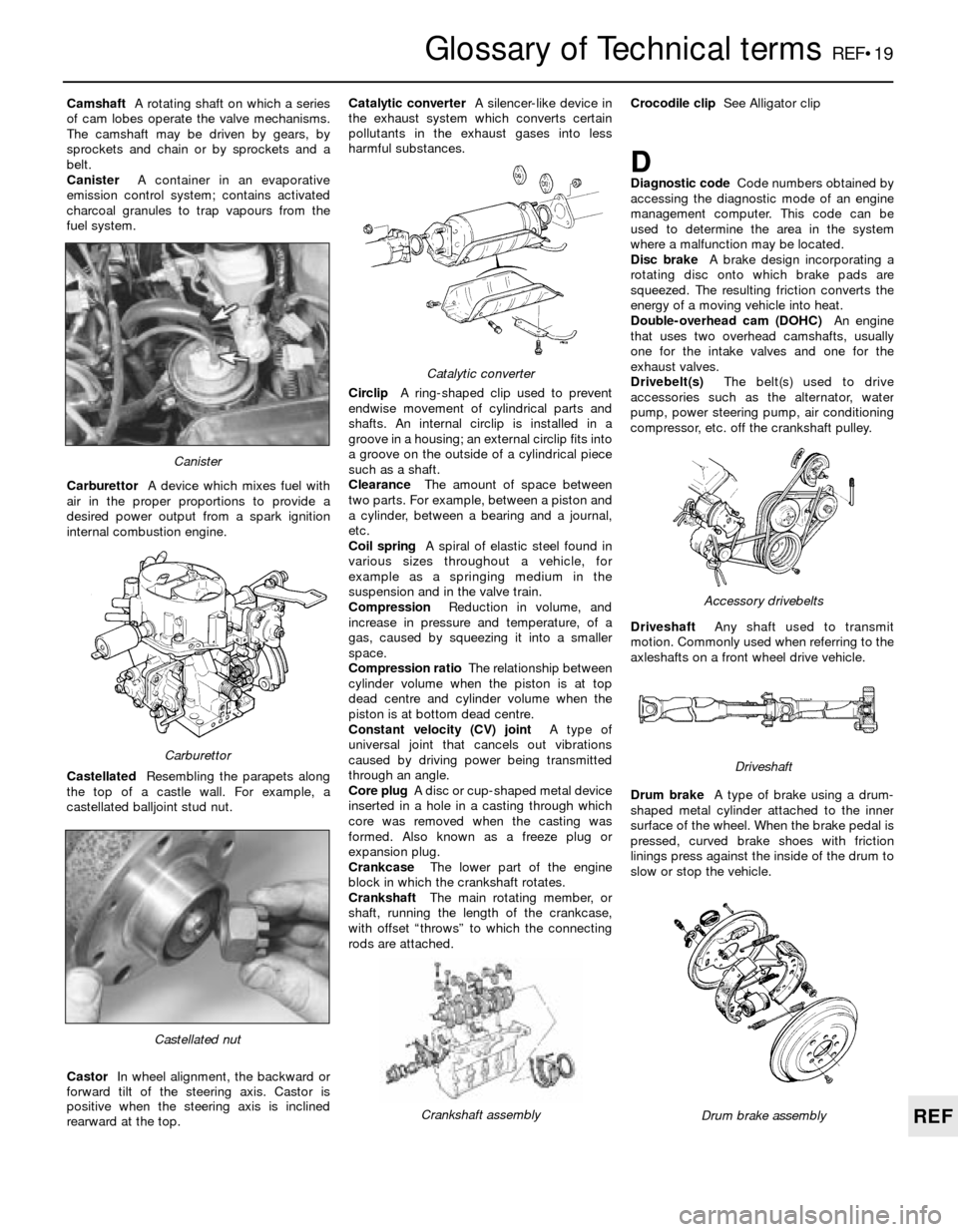
Glossary of Technical termsREF•19
REF
CamshaftA rotating shaft on which a series
of cam lobes operate the valve mechanisms.
The camshaft may be driven by gears, by
sprockets and chain or by sprockets and a
belt.
CanisterA container in an evaporative
emission control system; contains activated
charcoal granules to trap vapours from the
fuel system.
CarburettorA device which mixes fuel with
air in the proper proportions to provide a
desired power output from a spark ignition
internal combustion engine.
CastellatedResembling the parapets along
the top of a castle wall. For example, a
castellated balljoint stud nut.
CastorIn wheel alignment, the backward or
forward tilt of the steering axis. Castor is
positive when the steering axis is inclined
rearward at the top.Catalytic converterA silencer-like device in
the exhaust system which converts certain
pollutants in the exhaust gases into less
harmful substances.
CirclipA ring-shaped clip used to prevent
endwise movement of cylindrical parts and
shafts. An internal circlip is installed in a
groove in a housing; an external circlip fits into
a groove on the outside of a cylindrical piece
such as a shaft.
ClearanceThe amount of space between
two parts. For example, between a piston and
a cylinder, between a bearing and a journal,
etc.
Coil springA spiral of elastic steel found in
various sizes throughout a vehicle, for
example as a springing medium in the
suspension and in the valve train.
CompressionReduction in volume, and
increase in pressure and temperature, of a
gas, caused by squeezing it into a smaller
space.
Compression ratioThe relationship between
cylinder volume when the piston is at top
dead centre and cylinder volume when the
piston is at bottom dead centre.
Constant velocity (CV) jointA type of
universal joint that cancels out vibrations
caused by driving power being transmitted
through an angle.
Core plugA disc or cup-shaped metal device
inserted in a hole in a casting through which
core was removed when the casting was
formed. Also known as a freeze plug or
expansion plug.
CrankcaseThe lower part of the engine
block in which the crankshaft rotates.
CrankshaftThe main rotating member, or
shaft, running the length of the crankcase,
with offset “throws” to which the connecting
rods are attached.Crocodile clipSee Alligator clip
DDiagnostic codeCode numbers obtained by
accessing the diagnostic mode of an engine
management computer. This code can be
used to determine the area in the system
where a malfunction may be located.
Disc brakeA brake design incorporating a
rotating disc onto which brake pads are
squeezed. The resulting friction converts the
energy of a moving vehicle into heat.
Double-overhead cam (DOHC)An engine
that uses two overhead camshafts, usually
one for the intake valves and one for the
exhaust valves.
Drivebelt(s)The belt(s) used to drive
accessories such as the alternator, water
pump, power steering pump, air conditioning
compressor, etc. off the crankshaft pulley.
DriveshaftAny shaft used to transmit
motion. Commonly used when referring to the
axleshafts on a front wheel drive vehicle.
Drum brakeA type of brake using a drum-
shaped metal cylinder attached to the inner
surface of the wheel. When the brake pedal is
pressed, curved brake shoes with friction
linings press against the inside of the drum to
slow or stop the vehicle.
Castellated nut
Catalytic converter
Crankshaft assembly
Carburettor
Canister
Drum brake assembly
Accessory drivebelts
Driveshaft
Page 20 of 26
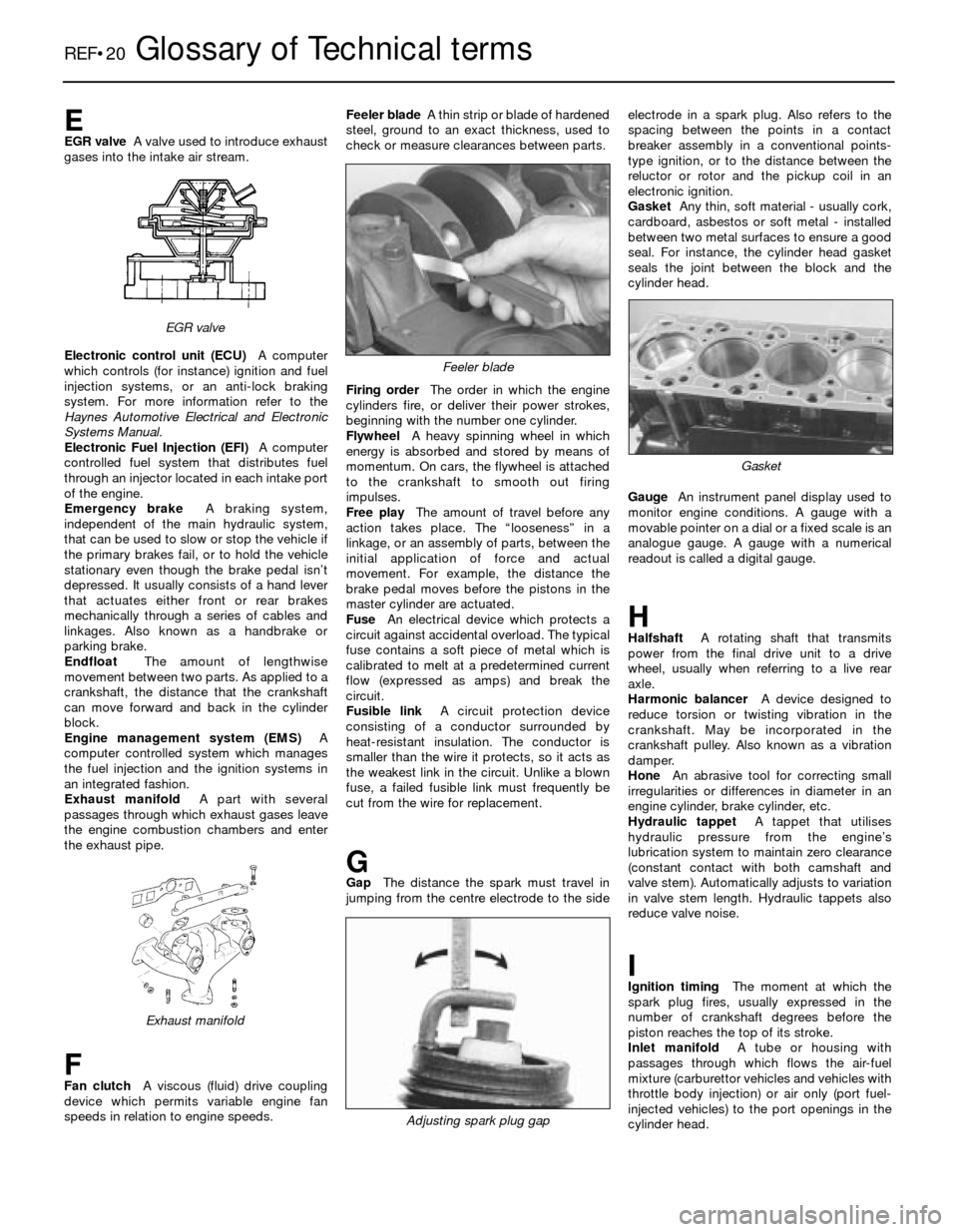
REF•20Glossary of Technical terms
EEGR valveA valve used to introduce exhaust
gases into the intake air stream.
Electronic control unit (ECU)A computer
which controls (for instance) ignition and fuel
injection systems, or an anti-lock braking
system. For more information refer to the
Haynes Automotive Electrical and Electronic
Systems Manual.
Electronic Fuel Injection (EFI)A computer
controlled fuel system that distributes fuel
through an injector located in each intake port
of the engine.
Emergency brakeA braking system,
independent of the main hydraulic system,
that can be used to slow or stop the vehicle if
the primary brakes fail, or to hold the vehicle
stationary even though the brake pedal isn’t
depressed. It usually consists of a hand lever
that actuates either front or rear brakes
mechanically through a series of cables and
linkages. Also known as a handbrake or
parking brake.
EndfloatThe amount of lengthwise
movement between two parts. As applied to a
crankshaft, the distance that the crankshaft
can move forward and back in the cylinder
block.
Engine management system (EMS)A
computer controlled system which manages
the fuel injection and the ignition systems in
an integrated fashion.
Exhaust manifoldA part with several
passages through which exhaust gases leave
the engine combustion chambers and enter
the exhaust pipe.
FFan clutchA viscous (fluid) drive coupling
device which permits variable engine fan
speeds in relation to engine speeds.Feeler bladeA thin strip or blade of hardened
steel, ground to an exact thickness, used to
check or measure clearances between parts.
Firing orderThe order in which the engine
cylinders fire, or deliver their power strokes,
beginning with the number one cylinder.
Flywheel A heavy spinning wheel in which
energy is absorbed and stored by means of
momentum. On cars, the flywheel is attached
to the crankshaft to smooth out firing
impulses.
Free playThe amount of travel before any
action takes place. The “looseness” in a
linkage, or an assembly of parts, between the
initial application of force and actual
movement. For example, the distance the
brake pedal moves before the pistons in the
master cylinder are actuated.
FuseAn electrical device which protects a
circuit against accidental overload. The typical
fuse contains a soft piece of metal which is
calibrated to melt at a predetermined current
flow (expressed as amps) and break the
circuit.
Fusible linkA circuit protection device
consisting of a conductor surrounded by
heat-resistant insulation. The conductor is
smaller than the wire it protects, so it acts as
the weakest link in the circuit. Unlike a blown
fuse, a failed fusible link must frequently be
cut from the wire for replacement.
GGapThe distance the spark must travel in
jumping from the centre electrode to the sideelectrode in a spark plug. Also refers to the
spacing between the points in a contact
breaker assembly in a conventional points-
type ignition, or to the distance between the
reluctor or rotor and the pickup coil in an
electronic ignition.
GasketAny thin, soft material - usually cork,
cardboard, asbestos or soft metal - installed
between two metal surfaces to ensure a good
seal. For instance, the cylinder head gasket
seals the joint between the block and the
cylinder head.
GaugeAn instrument panel display used to
monitor engine conditions. A gauge with a
movable pointer on a dial or a fixed scale is an
analogue gauge. A gauge with a numerical
readout is called a digital gauge.
HHalfshaftA rotating shaft that transmits
power from the final drive unit to a drive
wheel, usually when referring to a live rear
axle.
Harmonic balancerA device designed to
reduce torsion or twisting vibration in the
crankshaft. May be incorporated in the
crankshaft pulley. Also known as a vibration
damper.
HoneAn abrasive tool for correcting small
irregularities or differences in diameter in an
engine cylinder, brake cylinder, etc.
Hydraulic tappetA tappet that utilises
hydraulic pressure from the engine’s
lubrication system to maintain zero clearance
(constant contact with both camshaft and
valve stem). Automatically adjusts to variation
in valve stem length. Hydraulic tappets also
reduce valve noise.
IIgnition timingThe moment at which the
spark plug fires, usually expressed in the
number of crankshaft degrees before the
piston reaches the top of its stroke.
Inlet manifoldA tube or housing with
passages through which flows the air-fuel
mixture (carburettor vehicles and vehicles with
throttle body injection) or air only (port fuel-
injected vehicles) to the port openings in the
cylinder head.
Exhaust manifold
Feeler blade
Adjusting spark plug gap
Gasket
EGR valve